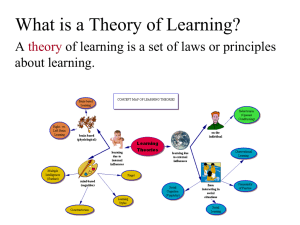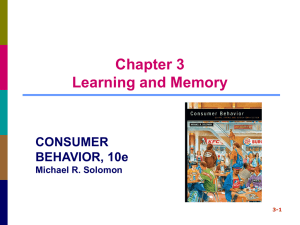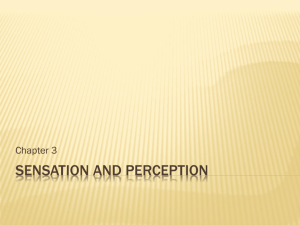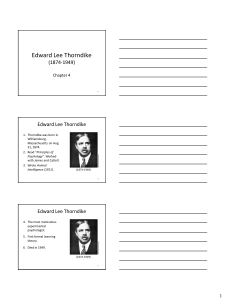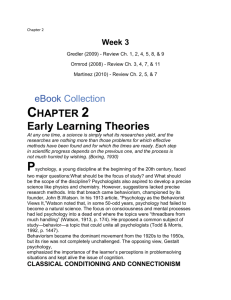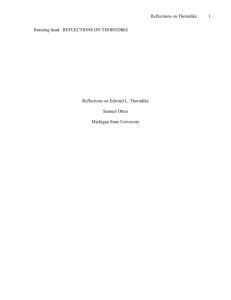Chapter Two: Early Learning Theories Matching, Multiple Choice
advertisement
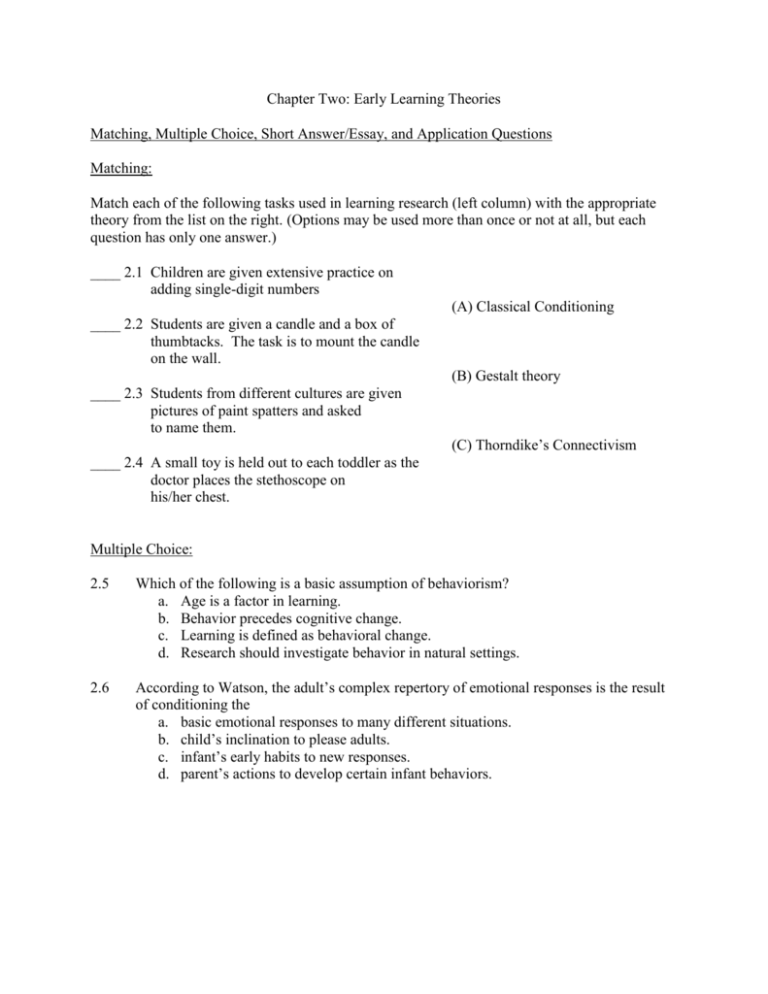
Chapter Two: Early Learning Theories Matching, Multiple Choice, Short Answer/Essay, and Application Questions Matching: Match each of the following tasks used in learning research (left column) with the appropriate theory from the list on the right. (Options may be used more than once or not at all, but each question has only one answer.) ____ 2.1 Children are given extensive practice on adding single-digit numbers (A) Classical Conditioning ____ 2.2 Students are given a candle and a box of thumbtacks. The task is to mount the candle on the wall. (B) Gestalt theory ____ 2.3 Students from different cultures are given pictures of paint spatters and asked to name them. (C) Thorndike’s Connectivism ____ 2.4 A small toy is held out to each toddler as the doctor places the stethoscope on his/her chest. Multiple Choice: 2.5 Which of the following is a basic assumption of behaviorism? a. Age is a factor in learning. b. Behavior precedes cognitive change. c. Learning is defined as behavioral change. d. Research should investigate behavior in natural settings. 2.6 According to Watson, the adult’s complex repertory of emotional responses is the result of conditioning the a. basic emotional responses to many different situations. b. child’s inclination to please adults. c. infant’s early habits to new responses. d. parent’s actions to develop certain infant behaviors. 2.7 The procedure of gradually introducing a feared object to a child while he/she is eating is an example of a. classical conditioning. b. counter conditioning. c. extinction. d. stimulus generalization. 2.8 In classical conditioning, stimulus generalization refers to a. the tendency of a secondary stimulus to elicit a reflex. b. the tendency for similar reflexes to respond to the same stimulus. c. training a reflex to respond in different situations. d. training a reflex to be resistant to an original stimulus. 2.9 Training a reflex to respond to a new stimulus requires the pairing of a UCS and a/a a. CS. b. NS. c. UCR. d. UCS2. 2.10 Which of the following is an example of a conditional compensatory response? a. After getting an adrenaline shot, the sight of the needle in the future decreases a person’s heart rate. b. Drinking alone has more of an effect on a person than drinking with others. c. For an addict, a change in where he/she typically uses the drug (e.g., at home vs. a hotel) increases tolerance. d. Someone used to smoking in his/her own car will usually have nicotine cravings upon entering anyone’s car. 2.11 According to Watson, emotional reactions that are instinctual include all of the following except a. fear. b. hate. c. love. d. rage. 2.12 The major law of learning according to Thorndike, is the presence of a. a response to partial stimulus elements. b. a satisfying state following a response. c. the repeated practice of all responses. d. the transfer to responses to similar stimuli. 2.13 According to Thorndike, attaining food produces behavioral change because it is a/an a. consequence for responses. b. example of the repeated practice of responses. c. primary reinforcer. d. satisfying state following a response. 2.14 According to Thorndike, knowledge is accounted for by a. a triggering stimulus and a response. b. established links between ideas. c. the presence of the practice effect. d. the phenomenon of associative shifting. 2.15 Pairing a product with pleasant images and/or sounds in a commercial is an example of a. classical conditioning. b. habit-formation theory. c. Hull’s hypothetico-deductive method. d. Thorndike’s connectionism. 2.16 The major assumption of Gestalt psychology is that a. learners respond to meaningful wholes. b. perception is the only learning process. c. problem solving is essential to learning. d. simplicity of elements is essential to learning. 2.17 According to Gestalt theory, the primary task of psychology is to determine a. how an individual attributes meaning to events. b. how an individual perceives the environment. c. ways in which perceived stimuli can be organized. d. why perceptual stimuli influence people. 2.18 According to Gestalt theory, all of the following influence one’s perception organization of a visual field except a. experience. b. proximity. c. similarity. d. simplicity. 2.19 According to the law of Prägnanz, the characteristics of a stimulus array that influence perception are a. causal and arbitrary. b. comprehensive and causal. c. comprehensive and stable. d. stable and causal. 2.20 According to Gestalt psychology, learning depends upon the learner’s a. analysis of the stimulus elements. b. analysis of the skill to be learned. c. structuring of the stimulus situation. d. synthesis of prior similar problems. 2.21 According to the Gestalt psychologists, insight refers to a. perception of a dynamic visual field. b. perception of disparate stimulus elements. c. recognition of stimuli as organized wholes. d. reorganization of the perceptual field. 2.22 Current research on the phenomenon of insight indicates the importance of a. incubation and independent research. b. mental overview and verification. c. mental preparation and incubation. d. studying with one mentor. 2.23 Recommendations of Gestalt psychology for classroom instruction of problem solving include all of the following except a. develop problems that reflect substance in the subject area. b. present problems isolated from other information. c. provide cues or hints to overcome students’ inadequate problem representations. d. use problems that have broadly applicable solutions. 2.24 Gestalt theory and behaviorism differ in all of the following ways except a. application to real-world situations. b. descriptions of learning. c. experimental contexts. d. use of precise measurements. Short Answer/Essay: 2.25 Unlike classical conditioning, Thorndike’s research addressed the learning of ____ __________________________________________________________________. 2.26 According to Thorndike, children should not be left to their own devices to learn to solve word problems in arithmetic. Why is this? 2.27 The importance of Pavlov’s research is that it demonstrated (list 2) _______________ _____________________________________________________________________. 2.28 Discovery of the phi phenomenon was importance because it demonstrated_________ _____________________________________________________________________. 2.29 According to Gestalt psychologists, the failure to use a yardstick as a lever to move a large object is an example of _____________________________________________. Application: 2.30 Robert is addicted to caffeine and drinks coffee throughout the day as part of his usual routine, particularly in the morning to help get him going. Recently, he changed jobs, which requires him to be at work an hour earlier. To save some time in the morning and sleep in as long as possible, he waits to drink his first cup of coffee until he gets to his office. He notices that he feels much more alert, not only in the morning, but all day long as well. Using one of the behaviorism theories of change, explain why he may be experiencing this increased alertness. 2.31 Provide an example from your own life in which you have experienced problem set and discuss how you overcame it. Chapter Two: Early Learning Theories 1. c 21. d 2. b 22. c 3. b 23. b 4. a 24. d 5. c 25. voluntary behaviors 6. a 26. They would form bonds that would have to be broken. 7. b 27. The potential of laboratory experiments to discover new 8. a knowledge; the manipulation of behavior in the 9. a laboratory. 10. a 28. That the relationships between stimulus configurations 11. b were not haphazard. 12. b 29. functional fixedness 13. d 30. The narrative should address conditional compensatory 14. b response at home and his old office, which is 15. a now lacking at the new office. 16. a 31. Various answers are possible; however, it should 17. b describe a problem set scenario and a strategy to 18. a counter it. 19. c 20. c

